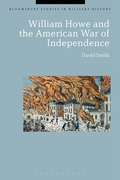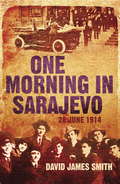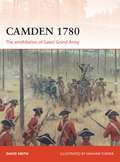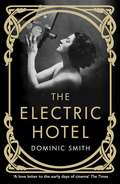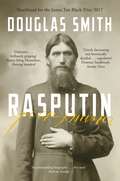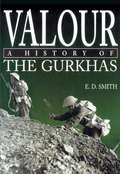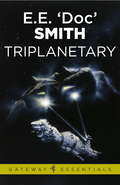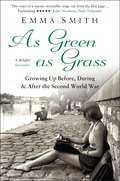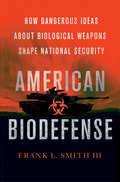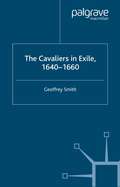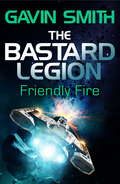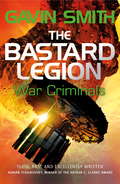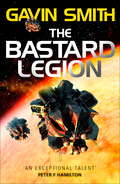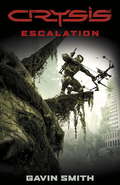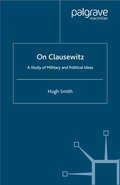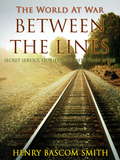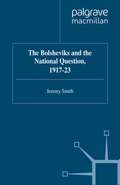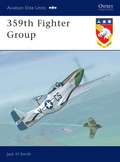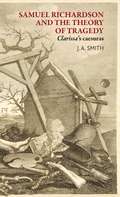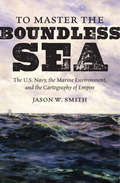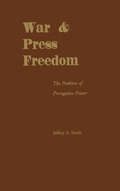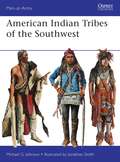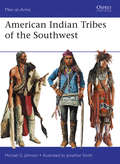- Table View
- List View
William Howe and the American War of Independence (Bloomsbury Studies in Military History)
by David SmithThe first major work on this enigmatic British general for more than 40 years, William Howe and the American War of Independence offers fascinating new insights into his performance during the revolution in America. From 1775 to 1777, Howe commanded the largest expeditionary force Britain had ever amassed, confronting the rebel army under George Washington and enjoying a string of victories. However, his period in command ended in confusion, bitterness and a parliamentary inquiry, because he proved unable to crush the rebellion. Exactly what went wrong has puzzled historians for more than 200 years. For most Howe has been relegated to the role of a bit player, but, with the help of new evidence, this book looks afresh at his army, his relationships with key military and political figures and his own personal qualities. The result is a compelling reassessment of a forgotten general that offers a new perspective on a man who won his battles, but could not win his war.
One Morning In Sarajevo: 28 June 1914
by David James SmithSarajevo, 28 June 1914: The story of the assassination that changed the world.A historical account of the assassination of Archduke Franz Ferdinand. Using newly available sources and older material, David James Smith brilliantly reinvestigates and reconstructs the events which subsequently determined the shape of the twentieth century.Young Gavrilo Princip arrived at the Vlajnic pastry shop in Sarajevo in Bosnia-Herzegovina on the morning of 28 June 1914. He was greeted by his fellow conspirators in the plot to kill Archduke Franz Ferdinand. The Archduke, next in line to succeed as Emperor of Austria, was beginning a state visit to Sarajevo later that morning. Ferdinand was not a very popular character - widely thought of as bad-tempered and arrogant and perhaps even deranged. To the young students he embodied everything they loathed about imperial oppression. They planned to kill him at about 11 o'clock as he paraded down Appel Quay to the town hall in his open top car.What happened in those few hours - leading as it did to the First and Second World Wars - is as compelling as any thriller.
Camden 1780: The annihilation of Gates’ Grand Army (Campaign #292)
by David Smith Graham TurnerAs the American Revolution continued, the British refocused their fight on the southern colonies in the hopes of triggering an outbreak of loyalism that would sweep the rebels aside. Under Sir Henry Clinton they captured Savannah at the end of 1778, and Charleston in May 1780, with Lord Cornwallis being left in command with just 8,500 men under him. Too thinly spread to guard the 15,000 square miles he was responsible for, Cornwallis went on the offensive, invading North Carolina and using Camden as a launch pad. This new history reveals how Cornwallis was able to use his aggressive strategy to great effect and how the overconfidence of the re-formed American forces under Horatio Gates was to result in a shocking defeat on the night of 15 August 1780 – a defeat that would allow Cornwallis to push deep into North Carolina the following year, where he would only be stopped by the American victory at Yorktown.
The Electric Hotel: A Novel
by Dominic SmithFrom the award-winning author of the acclaimed bestseller The Last Painting of Sara de Vos comes a radiant new novel tracing the intertwined fates of a silent film director and his muse.The Electric Hotel winds through the nascent days of cinema in Paris and Fort Lee, New Jersey - America's first movie town - and the battlefields of Belgium during World War I. A sweeping work of historical fiction, it shimmers between past and present as it tells the story of the rise and fall of a prodigious film studio and one man's doomed obsession with all that passes in front of the viewfinder.For nearly half a century, Claude Ballard has been living at the Hollywood Knickerbocker Hotel. A French pioneer of silent films, who started out as a concession agent for the Lumière brothers, the inventors of cinema, Claude now spends his days taking photographs of Sunset Boulevard. But when a film-history student comes to interview Claude about The Electric Hotel - the lost masterpiece that bankrupted him and ended the career of his muse, Sabine Montrose - the past comes surging back. In his run-down hotel suite, the ravages of the past are waiting to be excavated: celluloid fragments and reels in desperate need of restoration, and Claude's memories of the woman who inspired and beguiled him.The Electric Hotel is a portrait of a man entranced by the magic of movie-making, a luminous romance and a whirlwind trip through the heady, endlessly inventive days of early cinema.
Rasputin: The Biography
by Douglas SmithSHORTLISTED FOR THE JAMES TAIT BLACK PRIZENearly a century after his murder, Rasputin remains as divisive a figure as ever. Was he really a horse thief and a hard-drinking ruffian in his youth? Was he a a devout Orthodox Christian, or was he in fact a just a fake holy man? Are the stories of his enormous sexual drive, debauchery, and drunken orgies true or simply a myth? How did he come to know the emperor and empress and to wield so much influence over them? What was the source of his healing power? Was Rasputin running the government in the final years of his life? And if so, was he acting on his own or on the orders of more powerful, hidden forces? Did Prince Yusupov and his fellow conspirators act alone or were they other parties involved in Rasputin’s murder—British secret agents or even an underground cell of Freemasons, as has been claimed? And to what extent did Rasputin’s murder doom the Romanov dynasty? Drawing on major new sources hitherto unexamined by western historians, Douglas Smith’s book is be the definitive biography of this extraordinary figure for a generation.
Valour: The History of the Gurkhas (Joe And Henny Heisel Ser.)
by E D SmithSince the short and bloody war between Nepal and Britain in 1814-15, Gurkha volunteers, ever mindful of the their motto, 'It is better to die than be a coward', have fought and died for Britain, including in recent years in the Falklands, Afghanistan and Iraq. In the Second World War an astonishing quarter of a million Gurkhas fought aginst Germany and Japan. They have been awarded thirteen Victoria Crosses. Includes detailed appendices include all regimental changes and battle honours.
Triplanetary (The\lensman Ser.)
by E.E. 'Doc' SmithThe Arisians, benevolent humanoids who have declared themselves Guardians of Civilization, war with the Eddoreans, shapeless, malevolent beings, hungry for power at any price. They fight on both physical and mental levels, wielding weaponry of inconceivable destructiveness.And their battleground is a tiny planet in a remote galaxy: Earth. The swamping of Atlantis, the fall of Rome, the wars that wrack the world and blaze through space - all may seem historical accidents to the men involved, but each in reality is a move in a save universe-wide power struggle . . .
As Green As Grass: Growing Up Before, During And After The Second World War
by Emma SmithUprooted from her beloved Great Western Beach, Emma Smith moves with her family from Newquay to the Devonshire village of Crapstone. But the dust has hardly settled when tragedy strikes, and Emma's father, a DSO-decorated hero of the Great War, is so frustrated by the hardship of life as a lowly bank clerk and by his thwarted artistic ambitions that he suffers a catastrophic breakdown - from which disaster Emma's resourceful mother rallies courageously. Then, in 1939, the war again becomes a reality. Emma's sister Pam at once enlists with the WAAF and Jim, her politically minded brother, after initially declaring himself a pacifist, joins the RAF. But what should Emma, aged only sixteen, do? Secretarial collage equips her for a job with MI5 but it's dull work and Emma yearns for fresh air. She is rescued by a scheme taking on girls as crew for canal boats. Freedom! The war over, Emma travels to India with a documentary film company, lives in Chelsea, falls in love in France and spends time in Paris where she sets about mending a broken heart by writing her first novel. Sitting beside the Seine during a heatwave with her typewriter on her knees, she is unwittingly snapped by legendary photographer Robert Doisneau.The zest, thirst for life and buoyant spirits of Emma, as she recalls in evocative detail the quality of England in the thirties and forties give As Green as Grass the feel of a ready-made classic.
American Biodefense: How Dangerous Ideas about Biological Weapons Shape National Security (Cornell Studies in Security Affairs)
by Frank SmithBiological weapons have threatened U.S. national security since at least World War II. Historically, however, the U.S. military has neglected research, development, acquisition, and doctrine for biodefense. Following September 11 and the anthrax letters of 2001, the United States started spending billions of dollars per year on medical countermeasures and biological detection systems. But most of this funding now comes from the Department of Health and Human Services rather than the Department of Defense. Why has the U.S. military neglected biodefense and allowed civilian organizations to take the lead in defending the country against biological attacks? In American Biodefense, Frank L. Smith III addresses this puzzling and largely untold story about science, technology, and national security.Smith argues that organizational frames and stereotypes have caused both military neglect and the rise of civilian biodefense. In the armed services, influential ideas about kinetic warfare have undermined defense against biological warfare. The influence of these ideas on science and technology challenges the conventional wisdom that national security policy is driven by threats or bureaucratic interests. Given the ideas at work inside the U.S. military, Smith explains how the lessons learned from biodefense can help solve other important problems that range from radiation weapons to cyber attacks.
The Cavaliers in Exile 1640–1660
by G. SmithAs a consequence of their support for the royalist cause in the English civil wars, several hundred Cavaliers, often accompanied by their families, went into exile in Europe for periods ranging from a few weeks to twenty years. This is an original, ground-breaking study, that identifies which Cavaliers went into exile and explains how they coped with the wide range of circumstances that they encountered in the different countries in which they settled.
The Bastard Legion: Book 2 (The Bastard Legion)
by Gavin G. Smith'High octane SF adventure with Smith's trademark twist' Jamie Sawyer, author of The Lazarus War'An exceptional talent' Peter F HamiltonIn FRIENDLY FIRE, the Bastard Legion are hired to pull off a daring power-armoured heist of propriety tech. A crime-ridden colony world holds the secret to a potential alien contact, and various groups of mercenaries have been hired to discover it. None of the rest of them have little bombs implanted in their heads, though, so the Bastards have an advantage when it comes to motivation. And Miska, their commander and kidnapper both, is still on the hunt for the people who killed her father. People who might still be among her convicts.Getting the tech will be hard. Getting off the planet, deadly.'a brutal kaleidoscope of imagination' Hannu Rajaniemi, author of The Quantum Thief
The Bastard Legion: Book 3 (The Bastard Legion)
by Gavin G. SmithDirty, gritty and action-packed adventure featuring the galaxy's deadliest mercenaries, THE BASTARD LEGIONMILITARY SCIENCE FICTION AT ITS BEST. 'High octane SF adventure with Smith's trademark twist' Jamie Sawyer, author of The Lazarus War It was the kind of dirty, violent work the Bastards were made for. Protect a bunch of colonists in the Epsilon Eridani system, whose moon had become a war zone as megacorp-backed mercenaries fought a brutal proxy war. Just the kind of fight the penal mercenary legion liked. But a hundred headless corpses are hard to explain, even for the Bastard Legion, and soon they are on the run, abandoned by their allies, and hunted by their most dangerous foe yet . . . but Miska's going to play them at her own game. The Bastard Legion: the galaxy's most dangerous criminals controlled by implanted explosives and trained by the electronic ghost of a dead marine. 'Gloriously action-packed and often brutal military SF adventure . . .' Publishers Weekly 'An exceptional talent' Peter F HamiltonA 'Dirty Dozen' or 'Suicide Squad' for lovers of 'Aliens', THE BASTARD LEGION series is a down and dirty military SF set in a world of mercenary actions and covert operations.
The Bastard Legion: Book 1 (The Bastard Legion)
by Gavin G. Smith'High octane SF adventure with Smith's trademark twist' Jamie Sawyer'An exceptional talent' Peter F HamiltonFour hundred years in the future, the most dangerous criminals are kept in suspended animation aboard prison ships and "rehabilitated" in a shared virtual reality environment. But Miska Corbin, a thief and hacker with a background in black ops, has stolen one of these ships, the Hangman's Daughter, and made it her own. Controlled by explosive collars and trained in virtual reality by the electronic ghost of a dead marine sergeant, the thieves, gangsters, murderers, and worse are transformed into Miska's own private indentured army: the Bastard Legion. Are the mercenaries just for fun and profit, or does Miska have a hidden purpose connected to her covert past?'Gloriously action-packed and often brutal military SF adventure . . . This series launch will keep readers turning pages, eager to see what bloody adventure awaits and how the legion develops into a force to be reckoned with' Publishers Weekly STARRED REVIEW
Crysis: Escalation
by Gavin G. SmithTo tie in to the massive new game CRYSIS 3, coming in February 2013 from EA, Gavin Smith has been signed up to write a selection of connected short stories that will explore and expand the game world. Gavin's futuristic and punchy fiction is a perfect fit for CRYSIS, and this will be a delight for game-players and SF fans alike.With stories covering the fan favourite characters of Prophet, Psycho and Alcatraz, as well as introducing themes, enemies and weapons new to CRYSIS 3, this will be a vital part of the game experience. Punchy and kinetic, this is SF with steel at its heart.
On Clausewitz: A Study of Military and Political Ideas
by H. SmithClausewitz is often quoted but more often misunderstood. On Clausewitz presents his central ideas about war and politics - such as war as an instrument of policy, the concept of Absolute War, friction and the fog of war - in a clear and systematic fashion. It also presents the man, his life and the military and intellectual environment in which he produced his great work On War . A final section considers Clausewitz's relevance to the rapidly changing nature of war today.
Between the Lines / Secret Service Stories Told Fifty Years After: Secret Service Stories Told Fifty Years After (The World At War)
by Henry SmithFor those interested in the nitty gritty of the Civil War. It is hard to imagine living at a time and in a place where you were not sure where you and your friends stood. (Excerpt from Goodreads)
The Bolsheviks and the National Question, 1917–23 (Studies in Russia and East Europe)
by J. SmithIn a timely re-examination of the origins of the system which fell apart so dramatically in 1991, this book deals with the policies of the Soviets towards the non-Russian nationalities of the former Russian Empire. Making extensive use of previously unavailable material from the Soviet archives, Jeremy Smith explores the attempts of the Bolsheviks to promote the development of minority nationalities in the Soviet context, through a combination of political, cultural and educational measures, and looks at the disputes surrounding the creation of the Soviet Union.
359th Fighter Group (Aviation Elite Units #10)
by Jack H SmithNicknamed the 'Unicorns', the 359th FG was one of the last groups to arrive in the UK for service in the ETO with the Eighth Air Force. First seeing action on 13 December 1943, the group initially flew bomber escort sweeps in P-47s, before converting to the ubiquitous P-51 in March/April 1944. Throughout its time in the ETO, the 359th was credited with the destruction of 351 enemy aircraft destroyed between December 1943 and May 1945. The exploits of all 12 aces created by the group are detailed, along with the most significant missions flown. This book also discusses the various markings worn by the group's three squadrons, the 368th, 369th and 370th FSs
Samuel Richardson and the theory of tragedy: Clarissa's caesuras (PDF)
by James SmithSamuel Richardson and the theory of tragedy is a bold new interpretation of one of the greatest European novels, Samuel Richardson's Clarissa. It argues that this text needs to be rethought as a dangerous exploration of the ethics of tragedy, on the scale of the great arguments of post-Romantic tragic theory, from Hölderlin to Nietzsche, to Benjamin, Lacan and beyond. Taking the reader through the novel from beginning to end, it also acts as a guidebook for newcomers to Richardson's notoriously massive text, and situates it alongside Richardson's other works and the epistolary novel form in general. Filled with innovative close readings that will provoke scholars, students and general readers of the novel alike, it will also serve as a jumping off point for anyone interested in the way the theory of tragedy continues to be the privileged meeting point between literature and philosophy.
Samuel Richardson and the theory of tragedy: Clarissa's caesuras
by James SmithSamuel Richardson and the theory of tragedy is a bold new interpretation of one of the greatest European novels, Samuel Richardson's Clarissa. It argues that this text needs to be rethought as a dangerous exploration of the ethics of tragedy, on the scale of the great arguments of post-Romantic tragic theory, from Hölderlin to Nietzsche, to Benjamin, Lacan and beyond. Taking the reader through the novel from beginning to end, it also acts as a guidebook for newcomers to Richardson's notoriously massive text, and situates it alongside Richardson's other works and the epistolary novel form in general. Filled with innovative close readings that will provoke scholars, students and general readers of the novel alike, it will also serve as a jumping off point for anyone interested in the way the theory of tragedy continues to be the privileged meeting point between literature and philosophy.
To Master the Boundless Sea: The U.S. Navy, the Marine Environment, and the Cartography of Empire (Flows, Migrations, and Exchanges)
by Jason W. SmithAs the United States grew into an empire in the late nineteenth century, notions like "sea power" derived not only from fleets, bases, and decisive battles but also from a scientific effort to understand and master the ocean environment. Beginning in the early nineteenth century and concluding in the first years of the twentieth, Jason W. Smith tells the story of the rise of the U.S. Navy and the emergence of American ocean empire through its struggle to control nature. In vividly told sketches of exploration, naval officers, war, and, most significantly, the ocean environment, Smith draws together insights from environmental, maritime, military, and naval history, and the history of science and cartography, placing the U.S. Navy's scientific efforts within a broader cultural context.By recasting and deepening our understanding of the U.S. Navy and the United States at sea, Smith brings to the fore the overlooked work of naval hydrographers, surveyors, and cartographers. In the nautical chart's soundings, names, symbols, and embedded narratives, Smith recounts the largely untold story of a young nation looking to extend its power over the boundless sea.
War And Press Freedom: The Problem Of Prerogative Power
by Jeffery A. SmithIn the two centuries from the ratification of the First Amendment in 1791 through the Gulf War in 1991, the American press lacked an adequate right to analyze and report on the nation's armed conflicts. When restrictions were challenged as violations of the Constitution, military regulations and federal laws were justified as necessary under the "higher law" of survival. Is there law more important than the Constitution which allows prerogative powers to be used in a time of war or national crisis? This groundbreaking and provocative study, examining law and history over these two hundred years, argues that press freedom cannot and should not be suspended during armed conflict. The military and the media must work together because neither has authority over the other.
War and Press Freedom: The Problem of Prerogative Power
by Jeffery A. SmithWar and Press Freedom: The Problem of Prerogative Power is a groundbreaking and provocative study of one of the most perplexing civil liberties issues in American history: What authority does or should the government have to control press coverage and commentary in wartime? First Amendment scholar Jeffery A. Smith shows convincingly that no such extraordinary power exists under the Constitution, and that officials have had to rely on claiming the existence of an autocratic "higher law" of survival. Smith carefully surveys the development of statutory restrictions and military regulations for the news media from the ratification of the Bill of Rights in 1791 through the Gulf War of 1991. He concludes that the armed forces can justify refusal to divulge a narrow range of defense secrets, but that imposing other restrictions is unwise, unnecessary, and unconstitutional. In any event, as electronic communication becomes almost impossible to constrain, soldiers and journalists must learn how to respect each other's obligations in a democratic system.
American Indian Tribes of the Southwest (Men-at-Arms)
by Jonathan Smith Michael G JohnsonThis focuses on the history, costume, and material culture of the native peoples of North America. It was in the Southwest – modern Arizona, New Mexico, and parts of California and other neighboring states – that the first major clashes took place between 16th-century Spanish conquistadors and the indigenous peoples of North America. This history of contact, conflict, and coexistence with first the Spanish, then their Mexican settlers, and finally the Americans, gives a special flavor to the region. Despite nearly 500 years of white settlement and pressure, the traditional cultures of the peoples of the Southwest survive today more strongly than in any other region. The best-known clashes between the whites and the Indians of this region are the series of Apache wars, particularly between the early 1860s and the late 1880s. However, there were other important regional campaigns over the centuries – for example, Coronado's battle against the Zuni at Hawikuh in 1540, during his search for the legendary "Seven Cities of Cibola†?; the Pueblo Revolt of 1680; and the Taos Revolt of 1847 – and warriors of all of these are described and illustrated in this book.
American Indian Tribes of the Southwest (Men-at-Arms #488)
by Jonathan Smith Michael G JohnsonThis focuses on the history, costume, and material culture of the native peoples of North America. It was in the Southwest – modern Arizona, New Mexico, and parts of California and other neighboring states – that the first major clashes took place between 16th-century Spanish conquistadors and the indigenous peoples of North America. This history of contact, conflict, and coexistence with first the Spanish, then their Mexican settlers, and finally the Americans, gives a special flavor to the region. Despite nearly 500 years of white settlement and pressure, the traditional cultures of the peoples of the Southwest survive today more strongly than in any other region. The best-known clashes between the whites and the Indians of this region are the series of Apache wars, particularly between the early 1860s and the late 1880s. However, there were other important regional campaigns over the centuries – for example, Coronado's battle against the Zuni at Hawikuh in 1540, during his search for the legendary "Seven Cities of Cibola†?; the Pueblo Revolt of 1680; and the Taos Revolt of 1847 – and warriors of all of these are described and illustrated in this book.
